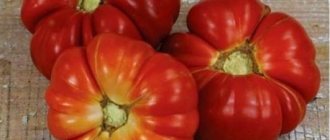Pepper-shaped tomatoes have managed to gain well-deserved popularity in Russia both among buyers and among gardeners - from amateurs to experienced breeders. Tomatoes of the Pepper-shaped robust variety have appetizing shapes, and they are also pleasant to the taste - juicy, with sweet crumbly pulp and a small amount of seeds.
With all its gastronomic advantages, the main advantage of Krepysh among its relatives in the pepper family is its unpretentiousness. Even for a novice gardener, the process of cultivating it will not cause much difficulty. A real dream for gardeners and housewives!
Characteristics and description of the variety
The first pepper tomatoes began to be imported to Russia from abroad 20 years ago. A distinctive feature of the variety is the elongated oblong shape of the fruit, reminiscent of a sweet pepper, from which they got their name.
In 2001, the State Register of Russia registered the first-born in this line - the Pepper-shaped tomato. And in 2014, the Pepper-shaped Krepysh tomato.
By the way. The ripe fruit is oblong in shape and has a pleasant pink color and weighs 100-150 g.
Distinctive features
This variety fully lives up to its name. He is solid and strong in the Siberian way. Bred by breeders of Western Siberia for cultivation in open ground, therefore it is well adapted to cold weather.
Pepper-shaped Krepysh has undeniable advantages:
- compact, low-growing bush reaches a height of only 30-40 cm, so does not require shaping, gartering or pinching;
- begins to bear fruit early, 105-110 days from germination;
- disease-resistant, has immunity to many viruses, including TMV (tobacco mosaic virus);
- unpretentious in care (compared to other varieties of pepper tomatoes), it responds well to watering and fertilizing with complex fertilizers.
See in the photo what the Pepper-shaped tough guy looks like.
Fruit characteristics and yield
The fruits of Krepysha are large, weighing 100-150 g. The shape does not exactly replicate the appearance of peppers, but is more smoothed and rounded. Color - from pale pink to rich crimson. Suitable for both fresh consumption and canning.
The yield of these tomatoes compared to other tall varieties is low - up to 4 kg per 1 sq. m. But this shortcoming is more than compensated for by the unpretentiousness of Krepysh. The variety is determinate, standard - its growth is limited and enters the fruiting phase when the bushes reach 30-40 cm. This significantly reduces the cost of growing it.
Important! Trellis are not required - the bushes do not need to be tied up, they do not need to be leveled or pinched.
Description of pepper varieties of tomatoes
A hybrid called “Pepper Tomato” was obtained on the basis of the popular tomato variety “Slivka”. Authorship belongs to agro. The hybrid was registered in 2001. The resulting product has an elongated and oblong shape, reminiscent of a pepper. Many later followers of the hybrid in question have improved characteristics in comparison with it.
Did you know? The closest relatives of tomatoes are potatoes and tobacco.
Giant
The “Pepper-shaped Giant” was created by Siberian specialists in 2005, and two years later Agro patented its work. The variety got its name due to the fact that its fruits were really large, but only in comparison with the original variety.
Characteristics of the "Pepper Giant":
- the average weight of a tomato of this variety is 200 g, individual specimens can reach a weight of 250–300 g;
- length up to 15 cm;
- A fully ripe tomato has a scarlet, rich, uniform color and a smooth surface;
- the taste is concentrated, fragrant, sweet, the flesh is fleshy and quite dense;
- the fruit has 3–4 chambers with not a very large number of seeds;
- the harvest can be harvested within 100–120 days after the seedlings begin to sprout;
- a large bush can grow up to 1.5–2 m tall;
- from 1 m² you can harvest up to 6 kg of crop;
- The product can be used universally.
Orange
Around the same time as “Giant,” breeders developed a variety called “Pepper Orange,” which grows well in the middle zone climate and achieves record results when grown in greenhouse conditions.
Characteristics of "Pepper Orange":
- the fruit weighs on average 135–170 g, can reach 300 g;
- the color to which the variety owes its name is rich and bright;
- the skin is dense, the flesh is juicy, fleshy and tender, while being quite thick;
- Before the start of harvesting, about 85–90 days pass from the first shoots, the variety bears fruit for a long time and abundantly;
- the bush can reach 150–180 cm in length;
- The variety is shade-tolerant and has increased resistance to a number of diseases characteristic of the crop;
- from 1 m² you can harvest 7–9 kg of crop;
- The product can be used universally.
Important! The seedlings of “Pepper Orange” stand out among other varieties in that they can tolerate insufficient light without harm.
Striped
The variety has an original color in the form of blurred yellow stripes and stains on the orange fruit.
Characteristics of the "Pepper Striped":
- the fruits are quite large - their average weight is 100–120 g;
- orange color with yellow streaks;
- the taste is excellent, the flesh is dense, as is the skin, which does not crack during heat treatment during canning;
- the bush is short, can grow up to 80 cm, in rare cases (in greenhouse conditions) reaches a meter in length;
- in general, the variety is resistant to diseases, with the exception of blossom end rot;
- begins to bear fruit 110–115 days after the seedlings hatch;
- from 1 m² you can harvest up to 7 kg of crop;
- Ideal for canning and delicious fresh.
Did you know? The word "tomato" has Aztec roots. In the original language it was called “tomatl”, the French changed it to “tomate”, from there the name passed into the Russian language.
Yellow
The tomato variety “Pepper Yellow” was developed in 2005. It has low acidity and is approved for consumption by those for whom tomatoes are not recommended for health reasons.
Characteristics of “Pepper Yellow”:
- fruit weight can reach 150 g;
- the color of the skin is orange, the flesh has a bright yellow tint;
- the pulp is medium-dense, aromatic, has excellent taste;
- fruiting occurs 116–120 days after germination;
- The length of the bush reaches 180 cm, needs pinching;
- the variety is resistant to heat and drought;
- increased resistance to many diseases characteristic of the culture;
- bears fruit for a long time, the yield from one bush reaches 3.5 kg;
- The product can be used universally.
Pink (raspberry)
The “Pepper Pink” (or crimson) variety was obtained relatively recently: Novosibirsk breeders bred it in 2015.
Characteristics of the variety in question:
- the fruit reaches a weight of 125–250 g;
- fully ripe, it acquires a rich crimson color;
- fruiting occurs 100 days after germination;
- the taste is excellent, sugary, the flesh is fleshy;
- The variety is determinate, the bush does not need pinching - being quite compact, it does not grow above one and a half meters;
- when grown in a greenhouse, it can produce 12–15 kg of yield per 1 m².
Did you know? The fruits of cultivated tomatoes can weigh up to 500 grams, and some up to a kilogram
—
despite the fact that its wild relatives bear fruit with small berries weighing 1 gram.
Sturdy
The “Pepper-shaped tough” variety was developed by Siberian specialists in 2014 in order to adapt it to harsh weather conditions.
Characteristics of the described variety:
- the fruit weighs up to 150 g;
- the color is crimson, the stalk may have a green spot that does not affect the taste;
- excellent taste, sweet flesh;
- begins to bear fruit after 105–110 days;
- the height of the bush does not exceed 40 cm, it does not need to be formed - the variety is determinate and standard;
- increased immunity to diseases;
- adapted to harsh climatic conditions, grows well in open ground;
- not very high yield (4 kg per 1 m²) is compensated by the taste, unpretentiousness of the variety and its adaptability even to the harsh Western Siberian conditions.
Cuban black
This variety may also be called “Cuban Pepper,” “Black Pepper,” or “Brown Cuban.”
Variety characteristics:
- the shape of the fruit is original, not too elongated and slightly corrugated, its weight varies from 200 to 350 g, but can reach 400 g or more;
- the color of the tomato is more brown than black;
- taste qualities are very high;
- has fleshy, fragrant pulp almost without seeds, but not everyone likes its dense skin;
- in a greenhouse, bushes grow about 2–3 meters, but in open ground they are rarely more than a meter long;
- With good greenhouse care, the yield can reach 10–12 kg per bush.
Did you know? In German the tomato is called the apple of paradise, in French
—
the apple of love, the Swedes call it a wolf peach.
Red
In 2015, the “Pepper Red” variety was obtained, bred by breeders. Overall it is almost identical to Pepper Orange with the only differences being the bright red color and some superior yield if properly cared for.
How to grow seedlings
In general, the process of growing Pepper-shaped fortress is the same as for other varieties of tomato, but there is a nuance. This is a hybrid variety. This means that seeds from tomatoes grown by yourself may not retain the main parental characteristics. Seeds need to be purchased. And do it from a reliable and verified source from a reputable manufacturer.
Seed preparation
They are soaked in diluted aloe juice for 12 hours to 24 hours or treated with a solution of potassium permanganate to kill fungi, viruses and increase plant immunity.
Container and soil
It is better to purchase a nutrient substrate for cultivation in a specialized store. It is usually packaged in paper bags marked “for tomatoes and peppers.” But you can prepare the soil yourself.
It's simple: mix peat, turf soil, compost and sand in a ratio of 2:1:1:0.5. To a bucket of this mixture, add 1 cup of wood ash and a complex fertilizer, which will include phosphorus, potassium and nitrogen. Such a substrate contains all the macro- and microelements necessary for the normal development of plants.
Prepare small boxes for seedlings filled with purchased or prepared soil.
Sowing
Seeds are planted in the substrate at least 50 days before transplanting to a permanent location. The sowing depth should be no more than 1-2 cm, and the width between the grooves 3-4 cm. The seeds are sprinkled with earth, watered abundantly and covered with film.
Read also: Creamy icing for cinnamon rolls
In the future, they must be ventilated regularly - at least once a day. The optimal temperature for germination is 22-25° C.
Growing and care
After the shoots emerge, the film is removed and the boxes are moved to a well-lit place. When the sprouts have 2-3 leaves, as carefully as possible so as not to damage the barely formed root system, they are planted (planted) with small pieces of soil in individual containers. Peat pots are best suited for this.
The sun and abundant watering will have a beneficial effect on the development of the root system and plants in general. To harden the seedlings, a week before transplanting them to a permanent place in the open ground, they are placed outside for 3-4 hours every day.
How to grow tomatoes
The next crucial moment is transplanting to permanent beds. Depending on the geographical location and climatic characteristics of the area, the landing time ranges from the end of April to the end of May. You can perform simple arithmetic operations.
The vegetative period of the Pepper-shaped fortress is 105-110 days. 50 of them or a little more should have already passed by the time of transplantation. This means that there are still 55-60 days left until the bright day of harvesting the fruits.
For example, farmers in central Russia can safely replant at the very beginning of May, because Krepysh is zoned for Siberia. Consequently, somewhere in the Samara or Nizhny Novgorod region the harvest will be ripe at the end of June.
If some liberties are allowed over time when Krepysha is planted, they are unacceptable with the location. Areas where potatoes, peppers, tobacco, tomatoes or other nightshade crops were grown in previous seasons are of little use and are even contraindicated for seedlings. The soil after cabbage, carrots, onions, dill or legumes is much more favorable.
Important! It is strongly recommended not to plant tomatoes in soil in which any plants of the nightshade family have previously been grown.
Landing
Unlike many of its fellow peppers and tomatoes in general, the pepper-shaped Krepysh causes noticeably less trouble when planting and cultivating. As a rule, it is planted in open ground - in pre-prepared depressions the size of peat pots. Based on 3-4, maximum 5 plants per 1 sq. m.
The variety is standard, so garters, trellises or any other structures are not required.
Seedlings should be watered abundantly with settled water and the top layer of soil around them should be loosened regularly. Loosening can be omitted at all, and watering can be done less frequently if you mulch - lay a layer of dry grass, leaves or pine needles around each plant. This will also almost completely save you from weeding.
Don’t forget about fertilizing with mineral fertilizers. The three most important minerals are nitrogen, phosphorus and potassium. The deficiency of one or another element can be judged by the appearance of the plants.
Here are the special signs of deficiency:
- nitrogen - yellowed leaves, elongated stems, the trunk becomes soft, and the veins on the underside of the leaf acquire a bluish tint;
- phosphorus - the stem becomes hard and brittle, and the leaves curl inward, the color of the plant changes to purple;
- potassium - the leaves darken, curl into a tube, brown spots appear along the edges, forming a border.
Based on this, fertilizers should be selected, replenishing the lack of certain mineral elements - one, two or several at once. You can make up the fertilizer yourself or purchase it ready-made in the form of a complex fertilizer.
“Feeding” will not only significantly improve the growth and durability of the bushes, but also the taste of the tomatoes. When applying complex fertilizers, strictly adhere to the dosages and recommendations given on the packaging.
Attention! There are many opinions and disputes about the amount of fertilizing. But most tomato growers believe that the required minimum is 4 times.
It is necessary to fertilize with mineral fertilizers at least 5 times during the growing season - by applying fertilizers at the roots of tomatoes and by spraying the bushes.
The most common complex mineral fertilizers and their main characteristics are listed below:
- Ammophos consists of nitrogen and phosphorus. It is presented in stores in granular form. The advantage of the drug is the absence of chlorine and nitrates. It accelerates the formation of the root system and promotes fruit ripening. It is used both in the process of feeding tomatoes and as the main soil fertilizer.
- Ammofoska contains all 3 minerals, in addition, it contains sulfur, potassium and magnesium, which contributes to additional nutrition of plants. Increases immunity to diseases and ensures full growth of the crop.
- Diammofoska is a complex fertilizer that, in addition to the main ones, contains 8 additional elements, including iron, zinc and manganese. Well nourishes tired soil, indispensable for greenhouses.
- Nitroammofoska is an effective fertilizer consisting of nitrogen, phosphorus, potassium and sulfur. Available in the form of granules, it can be used as spring and summer feeding.
- Nitrophoska containing a 3-component composition of mineral fertilizers. Well applicable to any type of soil, promotes intensive plant growth. Fertilizers not only improve the growth and durability of bushes, but also the taste of tomatoes.
Read also: Is it possible to go to the bathhouse if you have a cold?
Features of cultivation and possible difficulties
The main features of growing the pepper-shaped robust plant can be described in two words: simplicity and minimalism. Even for a novice amateur gardener, this process will not cause much difficulty.
Diseases and pests
Tobacco mosaic virus (TMV) is a real scourge of all nightshades, a persistent headache for several generations of gardeners. Pepper-shaped Sturdy is immune even to TMV! Pepper-shaped tomato varieties are generally less susceptible to diseases. Pests also avoid them, despite all the obvious taste benefits of peppers.
The only problem may be blackening of the fruit due to excess moisture at low temperatures. This is late blight. To prevent this disease, it is better to select a sunny and well-ventilated place for planting. A fungicide is used as a treatment agent. Recommendations for its use are described in detail in the instructions for the drug.
The nuances of growing in open ground and in a greenhouse
The hybrid was bred for cultivation in open ground, and in Siberian conditions. In addition, the Pepper-shaped toughy is inferior to its tall relatives in terms of productivity, i.e. the mass of collected fruits from the same area. Therefore, growing it in greenhouse conditions goes against common sense.
If Krepysh is planted in greenhouses, then only in temporary ones. Once the risk of severe cold snaps has subsided, they will be dismantled. But during this period, you need to carefully monitor humidity and temperature, and to avoid late blight, organize ventilation in the greenhouse
Harvesting and application
The harvest ripens in mid-summer. The fruits have a sweetish fleshy and crumbly pulp with a small amount of seeds. Therefore, tomatoes of this variety are used to prepare vegetable salads, consumed fresh, and also made into purees and juices for children.
Because of these same features, combined with a thick skin, the fruits of Krepysha are actively used in baked and stuffed form. They are optimally suited for whole-fruit canning. This is truly a universal variety.
Advantages and disadvantages of the variety
Let's summarize what is so remarkable about the Pepper-shaped tough guy:
- the growing technology is as simple as possible compared to other tomatoes;
- the fruits can be eaten fresh, stuffed and canned - the dense structure of the pulp does not allow it to fall apart during cooking;
- when preparing tomato juices and fruit purees, a large yield of the finished product is obtained due to the fleshiness of the fruit;
- under appropriate conditions, they retain not only their taste, but even their smell for a long time;
- tolerate transportation well.
The disadvantages include the relatively low yield per unit area.
Standard varieties of tomatoes for open ground - large-fruited
Some people like small tomatoes, which go great in salads and canned food. And some people like large, weighty, juicy fruits. To chop one such tomato, add herbs, and the salad with potatoes or meat is ready.
Danko tomatoes
It belongs to the mid-early variety, reaching maturity in 110 days. The fruits are large, can reach 300 g. Recommended for salads, does not tolerate transportation well (thin skin). For preservation, it is only suitable for preparing tomato juice and ketchup.
Crimson Giant
You can’t call it particularly short, it can grow up to 90 cm, a spreading bush, very productive. Summer residents love it for its massive fruits weighing up to 0.5 kg, sweet taste, and juiciness of the pulp. Ideal for salads and various sauces.
Orange
The bushes are miniature, 4-50cm, but very productive. Ripens in 100 days, fruits weigh up to 150 g, round, orange, healthy, tasty, universal purpose. Resistant to many diseases.
Fat Jack
The fruits are large, up to 300 g, red, flat-round, the bushes are small, but can produce up to 30 tomatoes per season. Ripening time is 110-115 days. It is necessary to tie it up so that the branches do not break. Early ripening and unpretentious.
Tomato Yamal
The early one, with berries weighing up to 180 g, produces a harvest within 95 days from the moment of germination. Excellent for northern regions because it is resistant to cold weather. It also tolerates rainy weather well and produces high fruit set. Fleshy, juicy, high quality tomatoes.
And also, on the advice of an experienced gardener Valery, I suggest watching a video about the wonderful hybrid of Dutch breeders Cyrise. Tomatoes weigh up to 250 g, productive, meaty, juicy, very tasty.
Farmer reviews
And here is what those who have already grown it say about the variety.
Valentina, Moscow: “The robust pepper tomato will appeal to all lovers of sweet pink varieties; it makes delicious salads, winter preparations and other vegetable dishes.”
Natalya, Ryazan: “A very tasty tomato that has a thick skin. It does not burst either during ripening or during canning. This is a fairly cold-resistant variety, so a sudden drop in temperature in the spring does not frighten young bushes.”
Description and characteristics of the variety
The pepper-shaped, robust tomato “Siberian Garden” is a semi-determinate low-growing variety, the height of which does not exceed a meter, but is often about 40 cm. It is considered early ripening, as it ripens 105-110 days after seed germination. Standard bush.
The tomatoes are medium-sized, 150 g or a little more, they have a pepper-shaped shape, but it does not exactly replicate the appearance of peppers, but is slightly more rounded. Color pink, universal use.
Planting and care
Seeds are sown in March-April. The soil is bought in the store, looking for the mark “for tomatoes and peppers,” or it is made up of garden soil, humus, peat, coarse sand and a small amount of fertilizer: superphosphate and wood ash.
The grains are buried in grooves 1-2 cm, located 3-4 cm from one another. Sprinkle it with soil, water it, cover it with film and keep it at a temperature of +22-25 degrees until germination. Periodically, the film is opened to ventilate the plantings. When the shoots appear, remove the film and move the boxes onto the windowsill, providing good lighting.
When the sprouts have 2-3 leaves, pick them; the best containers for this are peat pots.
7-10 days before transplanting into open ground, place the boxes outside for several hours to harden the seedlings.
They are planted in a permanent place in May-June. It is best to plant in beds where legumes, carrots, cabbage, onions, dill, and zucchini previously grew. Land after other nightshades should be avoided.
The tomatoes are watered with settled water, the soil is loosened and mulched to ensure a normal level of humidity. Feed periodically.

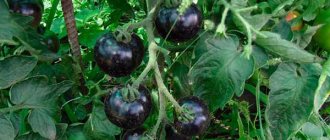
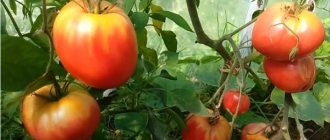
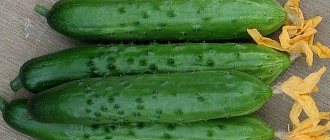
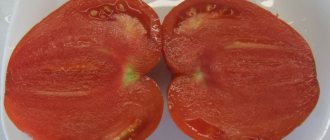

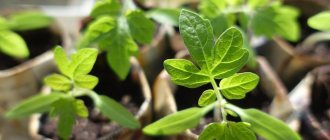
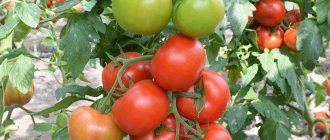

![Tinkoff (Debit card) [CPS] RU](https://adzumi-sushi.ru/wp-content/uploads/tinkoff-debetovaya-karta-cps-ru41-330x140.jpg)
